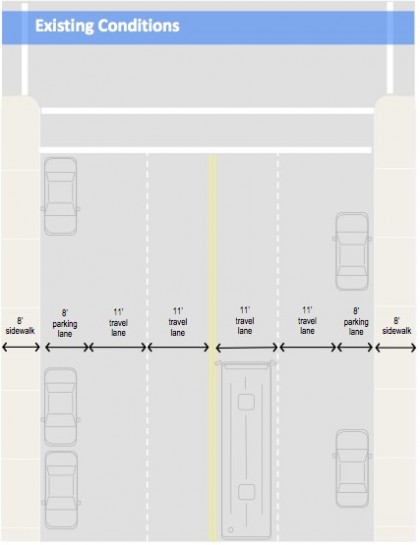
Portland Bicycle Plan for 2030.
(Thin orange lines are “City Bikeways”)
Given the existing bicycling environment on NE Sandy Boulevard, you might be surprised to learn that the street officially classified as a “City Bikeway.”
Here’s how the Portland Bicycle Plan for 2030 (section 2.3.3), defines City Bikeways:
“They establish direct and convenient bicycle access to all significant destinations… and function to allow residents access to Portland’s bikeway network, ideally within three city blocks from any given point. They provide a mobility function and help establish the fine-grained network of a world-class bicycling city…
Unless developed with separated facilities for bicycling, trails classified as City Bikeways would continue to operate with equal priority for people bicycling, walking or using other means of non-motorized transportation.”
“There are practical solutions for implementing a comfortable bikeway on Sandy while still accommodating freight and auto mobility.”
— Collin Roughton, PSU Masters of Urban and Regional Planning student
Given that, you might wonder what’s possible in terms of creating a Sandy Blvd that lives up to that definition. That’s where reader Collin Roughton comes in.
Roughton is a Masters of Urban and Regional Planning student at Portland State University. Last term he took a “Bicycle and Pedestrian Engineering Design” class in the civil engineering department as an elective. One of their assignments was to make Sandy compliant with the Bicycle Plan for 2030.
Roughton said the assignment turned out to be “complicated” because Sandy is also a major freight route and a priority streetcar corridor in various other city plans (we are city awash in plans if you haven’t realized that already). Even so, he still feels more can be done to make Sandy better for everyone.
“There are practical solutions for implementing a comfortable bikeway on Sandy while still accommodating freight and auto mobility, and even potential future streetcar service.”
Roughton and his classmate Chloe Ritter came up with two options; a buffered bike lane and a parking-protected cycle track (similar to SW Broadway near PSU). (He says simply narrowing existing lanes to make a conventional 4-5 foot bike lane wasn’t even under consideration because, “Both research and experience indicate that most people will not use narrow conventional bike lanes on high-speed, high-volume arterials.”)
See the graphics below for existing conditions on Sandy followed by Roughton and Ritters’ two options:



The big question is, what is our opportunity to actually make changes to Sandy? Turns out, PBOT is just about underway on a major project that will repave and rebuild Sandy from NE 47th to NE 82nd. We’ve asked contacts at PBOT whether or not any striping changes are possible.
As for what Roughton and Ritter proposed? “Our professor sent our proposals to the City,” Roughton tells us, “but who knows if/when we’ll see a bike facility on Sandy.”
Of course, there are some who feel simply adding sharrows to the outermost lane would suffice.
“PBOT should just paint the sharrows after the repaving,” says frequent BikePortland commenter “BURR”, “as it will take another 10 to 20 years to agree on, design, fund and build anything else, and doing nothing in the interim is not an acceptable solution.”
UPDATE: A commenter on the other Sandy story unearthed an interesting excerpt from the City of Portland’s 2005 Sandy Boulevard Resurfacing and Streetscape Project Plan (PDF):
“Sandy Boulevard is a designated City Bikeway, and many cyclists travel on it between downtown and NE Portland, as well as between the surrounding residential areas and shops along the street. It is, however, a challenging cycling environment.
Due to the right-of-way constraints and the corridor’s need for on-street parking and auto capacity, bike lanes are not planned for Sandy Boulevard…”

